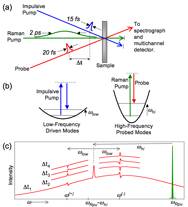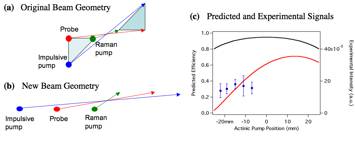www.acsprf.org
Reports: DNI649931-DNI6: Two-Dimensional Raman Spectroscopy of Metallocenes: Probing the Dynamics of Organometallic Bonds
David W. McCamant, PhD , University of Rochester
Overview
Between September 2010 and October 2011, our group continued work to develop two-dimensional femtosecond stimulated Raman spectroscopy (2D-FSRS) as a methodology to investigate vibrational coupling in hydrocarbons and metallocenes. Financial support from the Petroleum Research Fund (PRF) was used to support the stipends of two graduate students in physical chemistry, Kristina Wilson and Barbara Dunlap, the summer salary of the principle investigator, attendance at several conferences and to purchase a variety of optics necessary for these experiments.
The support of the ACS PRF has made a significant positive impact on the Prof. McCamant's career and those of his graduate students. In particular, the funds made it possible for Prof. McCamant to attend the Vibrational Spectroscopy Gordon Research Conference in 2010, where contacts and collaborations were initiated that have influenced the directions that this research has taken. Additionally, the PRF funds allowed Kristina Wilson to attend the 2010 International Conference on Raman Spectroscopy. At the conference, she presented her 2D-FSRS work and was inspired by discussions with other specialists in the field. That inspiration has strongly influenced her current job search while she finishes her PhD. For Barabara Dunlap, receiving a summer stipend from the PRF allowed her to begin her PhD research as soon as possible after her first year in graduate school by eliminating the need for additional teaching assistantships to support her stipend.
Scientific Progress
As shown in Figure 1, 2D-FSRS requires the use of three ultrafast laser pulses to measure a fifth-order Raman transition in the molecule of interest. 2D-FSRS holds promise as a method by which chemists could measure not just the fundamental frequencies at which different parts of molecule vibrate, but also the coupling between those vibrational modes. This vibrational coupling can provide insight into how vibrational energy moves through the molecule from one vibration to another in a process termed intramolecular vibrational energy redistribution (IVR). Additionally, in metallocenes, the vibrational coupling between intraligand vibrations and the metal-ligand bond vibrations can measure details of the electronic structure of the metal-ligand bond, for instance the extent to which covalent bonding arise from a migration of electron density from metallic d orbitals into the pi orbitals of the ligand.
In the first year of PRF support, 2009-1010, we demonstrated that signals previously attributed to vibrational coupling were actually due to an artifact, a coherent Raman cascade, that provides no information on vibrational coupling. In two publications, we developed a quantitative classical theory of 2D-FSRS and showed that the cascade dominates the observed signal by approximately a factor of 1000. Over the course of the second year of funding, 2010-2011, we have developed and implemented several new methods that serve to attenuate the cascade signal, with the hope that once they are sufficiently attenuated we will be able to observe the 5th-order signal that measures vibrational coupling.
FIGURE 1. (a) Schematic of 2D-FSRS experiment. (b) The impulsive pump drives a low-frequency vibrational mode into coherence, and the Raman pump and probe together take a stimulated Raman spectrum of the sample. (c) The detected spectrum of the probe measures the interaction between the impulsively driven modes and the modes probed by FSRS. In the presence of anharmonic coupling between the driven (wlow) and probed (whi) modes or via a coherent cascade, sidebands are observed in the stimulated Raman spectrum at Raman shifts of w=w(+)=wRpu-(whi+wlow) and w=w(-)=wRpu-(whi-wlow). The phase of the sideband field varies with changes in time delay, Dt, and produces a time dependent lineshape.
In 2010 and 2011, we developed a new phasematching geometry that theoretical calculations indicated would attenuate the cascade by a factor of ten and would leave the 5th-order signal unaffected. As shown in Figure 2, bringing the impulsive and Raman pump beams into the sample at a large angle should attenuate its signal to 10% of its original strength. However, a series of difficult experiments revealed that Snell's law refraction at the surface of the liquid sample severely attenuated the predicted effect by effectively reducing the crossing angle between the pump beams.
Figure 2. Phasematching geometry for 2D-FSRS. (a) and (b) compare the original and new beam geometries. In (c), the calculated phasematching efficiency of the vibrational coupling signal (black line) and the cascade artifact (red line) are shown, along with the experimental data (blue points). It was found that Snell's law refraction at the surface of the sample attenuated the effect of the large crossing angle between the beams and thereby eliminated the predicted improvement.
Our theoretical analysis predicted that the cascade should scale as N2, the concentration of the probed molecules squared, but that the 5th order vibrational coupling signal should scale simply with N, i.e. linear in concentration. Hence, a 1:10 dilution of the probed molecules should result in a hundred fold attenuation of the cascade and a ten fold attenuation of the signal. Using the new CCD detector purchased with PRF funds in the first year of funding, we were able to significantly improve the signal-to-noise ratio in our spectra, making these dilution experiments possible. However, extensive experiments found that a 1:10 dilution was able to completely attenuate the cascade, but that at that dilution level we can no longer measure the 5th order signal.
Fundamentally, the 5th order Raman signal is severely hampered because it depends on a two quantum transition that is formally forbidden in the harmonic oscillator basis set while the cascade produces overlapping signal via two sequential and fully allowed one-quantum transitions. Our solution is to pursue a new type of 7th order Raman spectroscopy that will observe vibrational coupling via a quantum pathway that only requires one-quantum transitions. This new 2D-FSRS technique is the direct Raman analog of two-dimensional infrared spectroscopy and will allow us to measure anharmonic between low-frequency modes (wlow < 1000 cm-1) all other Raman active vibrations (0 < whi < 4000 cm-1). Experiments to probe the 7th order Raman signal are currently being initiated.


